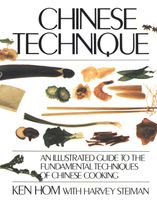Advertisement
Steaming
Appears in
By Ken Hom
Published 1981
Steaming cooks food gently in moist heat. Since few Chinese homes have ovens, the steamer is the piece of equipment most often used in its place. Even breads are steamed. Steamed food tends to be subtler in taste than the same food cooked in other ways. Steaming is generally used for delicate and easily abused foods like fish. It is also a fine way to extract fat from duck, or to warm cooked foods without drying them out, or to prepare foods that are easily overcooked.
- Put some water in the bottom of the wok. Use enough that it won’t boil away, but not so much that it touches the steamer basket or the plate on which the food to be steamed is to be placed.
- The food must be suspended at least 1 inch above the water level. Small pieces of food can be placed in a bamboo steamer basket lined with cheesecloth. The cheesecloth keeps the food from sticking to the steamer and ensures that the bamboo won’t flavor the food.
- Larger pieces, such as whole fish, can be steamed on a plate. Put the plate on a trivet, inverted heatproof bowl, or empty metal can opened at both ends, to keep it more than 1 inch above the water level. Bring the water to a boil before putting the food in the steamer.
- Cover the wok tightly so that the steam is captured under the lid and can circulate freely around the food.
- Keep a kettle of water on hand to replenish the steaming liquid in the wok if the level gets too low. Be careful not to pour the water onto the food. Food takes about twice as long to steam as it does to boil.







